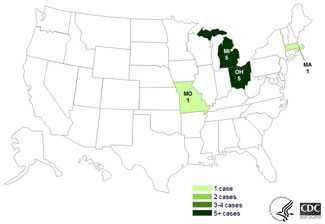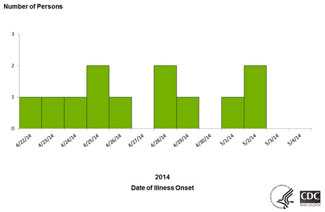Multistate Outbreak of Shiga toxin-producing Escherichia coli O157:H7 Infections Linked to Ground Beef (Final Update)
Posted June 20, 2014 3:30 PM ET
This outbreak appears to be over. However, E. coli is still an important cause of human illness in the United States. More information about E. coli, and steps people can take to reduce their risk of infection, can be found on the CDC E. coli Web Page.
Highlights
- Read the Advice to Consumers & Restaurants »
- A total of 12 persons infected with the outbreak strains of Shiga toxin-producing Escherichia coli O157:H7 (STEC O157:H7) were reported from 4 states.
- 58% of ill persons were hospitalized. No ill persons developed hemolytic uremic syndrome (HUS), and no deaths were reported.
- Epidemiologic and traceback investigations conducted by local, state, and federal officials indicated that contaminated ground beef produced by Wolverine Packing Company was the likely source of this outbreak of STEC O157:H7 infections.
- On May 19, 2014, Wolverine Packing Company recalled approximately 1.8 million pounds of ground beef products that may be contaminated with STEC O157:H7.
- The products subject to recall bear the establishment number “EST. 2574B.”
- The recalled ground beef was shipped to distributors for retail and restaurant use nationwide. There was no distribution of the products to the U.S. Department of Defense, the National School Lunch Program, or catalog/internet sales.
- Although the use-by date of the recalled ground beef products has passed, consumers and restaurants might still have recalled ground beef in their freezers if the ground beef was frozen.
- Consumers should check their freezers for recalled ground beef products and should not attempt to cook the ground beef and eat it.
- Restaurants should check their ground beef products for the recalled establishment number and should not attempt to cook the ground beef and serve it.
- Consumers should not eat raw or undercooked ground beef.
- Cook ground beef hamburgers and beef mixtures such as meat loaf to 160°F internal temperature using a food thermometer.
- Ask that ground beef hamburgers and beef mixtures be cooked to 160°F internal temperature when ordering at a restaurant.
- This outbreak appears to be over. However, E. coli is still an important cause of human illness in the United States. More information about E. coli, and steps people can take to reduce their risk of infection, can be found on the CDC E. coli Web Page.
Outbreak Summary
Introduction
CDC collaborated with public health officials in several states and the U.S. Department of Agriculture’s Food Safety and Inspection Service (USDA-FSIS) to investigate a multistate outbreak of Shiga toxin-producing Escherichia coli O157:H7 (STECO157:H7) infections. Public health investigators used the PulseNet system to identify cases of illness that were part of this outbreak. PulseNet, the national subtyping network of public health and food regulatory agency laboratories coordinated by CDC, obtains DNA "fingerprints" of E. coli bacteria through diagnostic testing with pulsed-field gel electrophoresis, or PFGE.
A total of 12 individuals infected with the outbreak strains of STEC O157:H7 were reported from 4 states. The number of ill persons identified in each state was as follows: Massachusetts (1), Michigan (5), Missouri (1), and Ohio (5).
Among persons with available information, dates that illnesses began range from April 22, 2014 to May 2, 2014. Ill persons ranged in age from 16 years to 46 years, with a median age of 25 years. Fifty-eight percent of ill persons were male. Among 12 persons with available information, 7 (58%) were hospitalized. No ill persons developed HUS, and no deaths were reported.
Investigation of the Outbreak
Epidemiologic and traceback investigations conducted by officials in local, state, and federal public health, agriculture, and regulatory agencies indicated that ground beef produced by Wolverine Packing Company was the likely source of this outbreak of STEC O157:H7 infections.
In interviews, ill persons answered questions about foods eaten and other exposures during the week before becoming ill. Eleven (92%) of 12 ill persons interviewed reported eating ground beef prepared as a hamburger at a restaurant before becoming ill. Of these 11 ill persons, 8 (73%) reported that they may have eaten the hamburger prepared rare, medium rare, or “undercooked.”
Findings of multiple traceback investigations of the ground beef used at restaurants where ill persons reported they had dined identified Wolverine Packing Company as the source of the ground beef. On May 19, 2014, Wolverine Packing Company, a Detroit, Michigan firm, recalled approximately 1.8 million pounds of ground beef that may be contaminated with STEC O157:H7. The ground beef was shipped to distributors for retail and restaurant use nationwide. There was no distribution of the products to the U.S. Department of Defense, the National School Lunch Program, or catalog/internet sales. The recalled ground beef was also distributed to a limited number of retail establishments for consumer purchase. Products are regulated by USDA-FSIS and bear the establishment number “EST. 2574B” inside the USDA mark of inspection and have a production date code in the format “Packing Nos: MM DD 14” between “03 31 14” and “04 18 14.” USDA-FSIS has completed food recall effectiveness checks.
June 20, 2014
Final Case Count Update
A total of 12 individuals infected with the outbreak strains of STEC O157:H7 were reported from 4 states. Since the last update on May 19, 2014, one additional ill person was reported from Ohio. The total number of ill persons identified in each state was as follows: Massachusetts (1), Michigan (5), Missouri (1), and Ohio (5).
Among persons with available information, dates that illnesses began range from April 22, 2014 to May 2, 2014. Ill persons ranged in age from 16 years to 46 years, with a median age of 25 years. Fifty-eight percent of ill persons were male. Among 12 persons with available information, 7 (58%) were hospitalized. No ill persons developed HUS, and no deaths were reported.
This outbreak appears to be over. However, E. coli is still an important cause of human illness in the United States. More information about E. coli, and steps people can take to reduce their risk of infection, can be found on the CDC E. coli Web Page.
May 19, 2014
Initial Announcement
CDC is collaborating with public health officials in several states and the U.S. Department of Agriculture’s Food Safety and Inspection Service (USDA-FSIS) to investigate a multistate outbreak of Shiga toxin-producing Escherichia coli O157:H7 (STECO157:H7) infections. Public health investigators are using the PulseNet system to identify cases of illness that may be part of this outbreak. PulseNet, the national subtyping network of public health and food regulatory agency laboratories coordinated by CDC, obtains DNA "fingerprints" of E. coli bacteria through diagnostic testing with pulsed-field gel electrophoresis, or PFGE.
The type of bacteria responsible for this outbreak is among those referred to as Shiga toxin-producing E. coli,or STEC. Some types of STEC frequently cause severe disease, including bloody diarrhea and hemolytic uremic syndrome (HUS), which is a type of kidney failure. STEC bacteria are divided into serogroups (e.g., O157 or O121). E. coli O157 is the STEC serogroup found most commonly in U.S. patients.
A total of 11 individuals infected with the outbreak strains of STEC O157:H7 have been reported from 4 states. The number of ill persons identified in each state is as follows: Massachusetts (1), Michigan (5), Missouri (1), and Ohio (4).
Among persons for whom information is available, illness onset dates range from April 22, 2014 to May 2, 2014. Ill persons range in age from 19 years to 46 years, with a median age of 26 years. Fifty-four percent of ill persons are male. Among 10 persons with available information, 6 (60%) reported being hospitalized. No ill persons have developed HUS, and no deaths have been reported.
This outbreak can be visually described with a chart showing the number of persons who became ill each day. This chart is called an epidemic curve or epi curve. Illnesses that began after May 1, 2014 might not yet be reported due to the time it takes between when a person becomes ill and when the illness is reported. This takes an average of 2 to 4 weeks. Please see the Timeline for Reporting Cases of E. coli O157 Infection for more details.
Investigation of the Outbreak
Epidemiologic and traceback investigations conducted by officials in local, state, and federal public health, agriculture, and regulatory agencies indicate that ground beef produced by Wolverine Packing Company is the likely source of this outbreak of STEC O157:H7 infections.
As of May 16, 2014, in interviews, ill persons answered questions about foods eaten and other exposures during the week before becoming ill. Ten (100%) of ten ill persons interviewed reported eating ground beef prepared at a restaurant before becoming ill.
Findings of multiple traceback investigations of the ground beef used at restaurants where ill persons reported they had dined identified Wolverine Packing Company as the source of the ground beef. On May 19, 2014, Wolverine Packing Company, a Detroit, Michigan firm, voluntarily recalled approximately 1.8 million pounds of ground beef that may be contaminated with STEC O157:H7. The ground beef was shipped to distributors for retail and restaurant use nationwide. There was no distribution of the products to the Department of Defense, the National School Lunch Program, or catalog/internet sales. Products are regulated by USDA-FSIS and bear the establishment number “2574B” inside the USDA mark of inspection and have a production date code in the format “Packing Nos: MM DD 14” between “03 31 14” and “04 18 14.”
CDC and state and local public health partners are continuing laboratory surveillance through PulseNet to identify additional ill persons and to interview them about foods eaten before becoming ill. USDA-FSIS is continuing to work closely with CDC and state partners during this investigation to determine the source of contamination and identify any other potentially contaminated products still on the market. CDC will update the public when additional information is available.
More Information
- Page last reviewed: June 20, 2014
- Page last updated: June 20, 2014
- Content source:


 ShareCompartir
ShareCompartir

